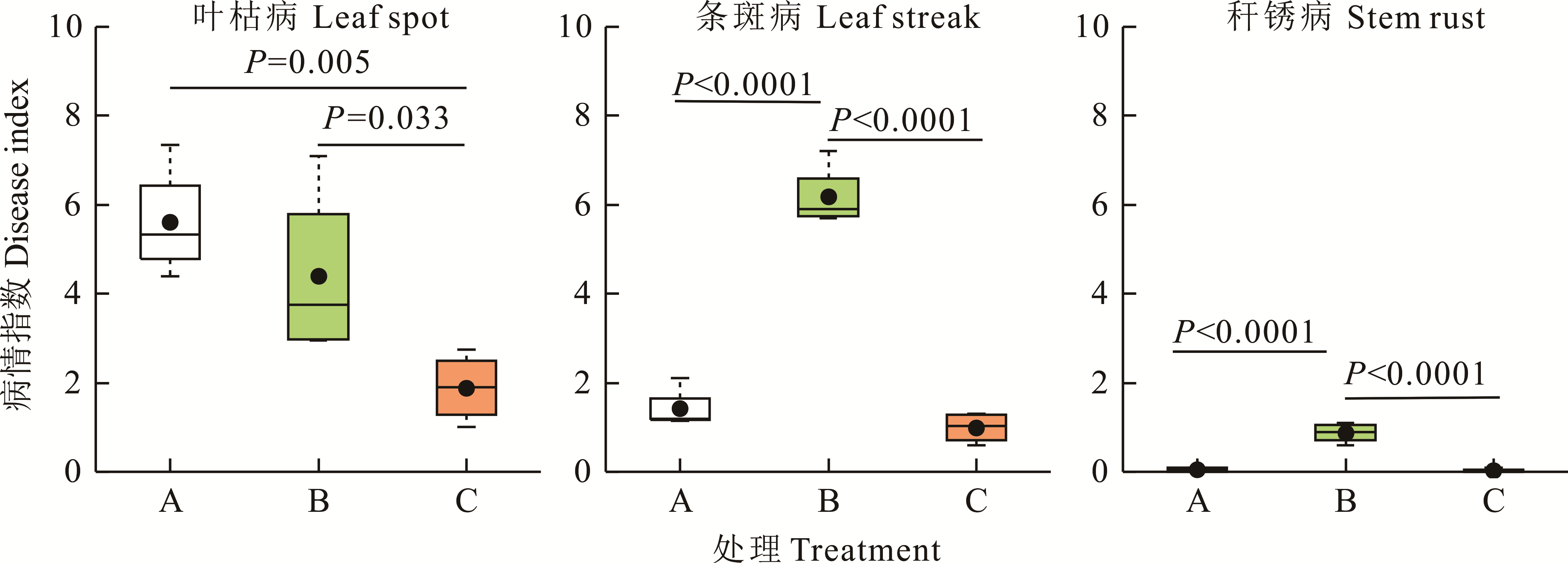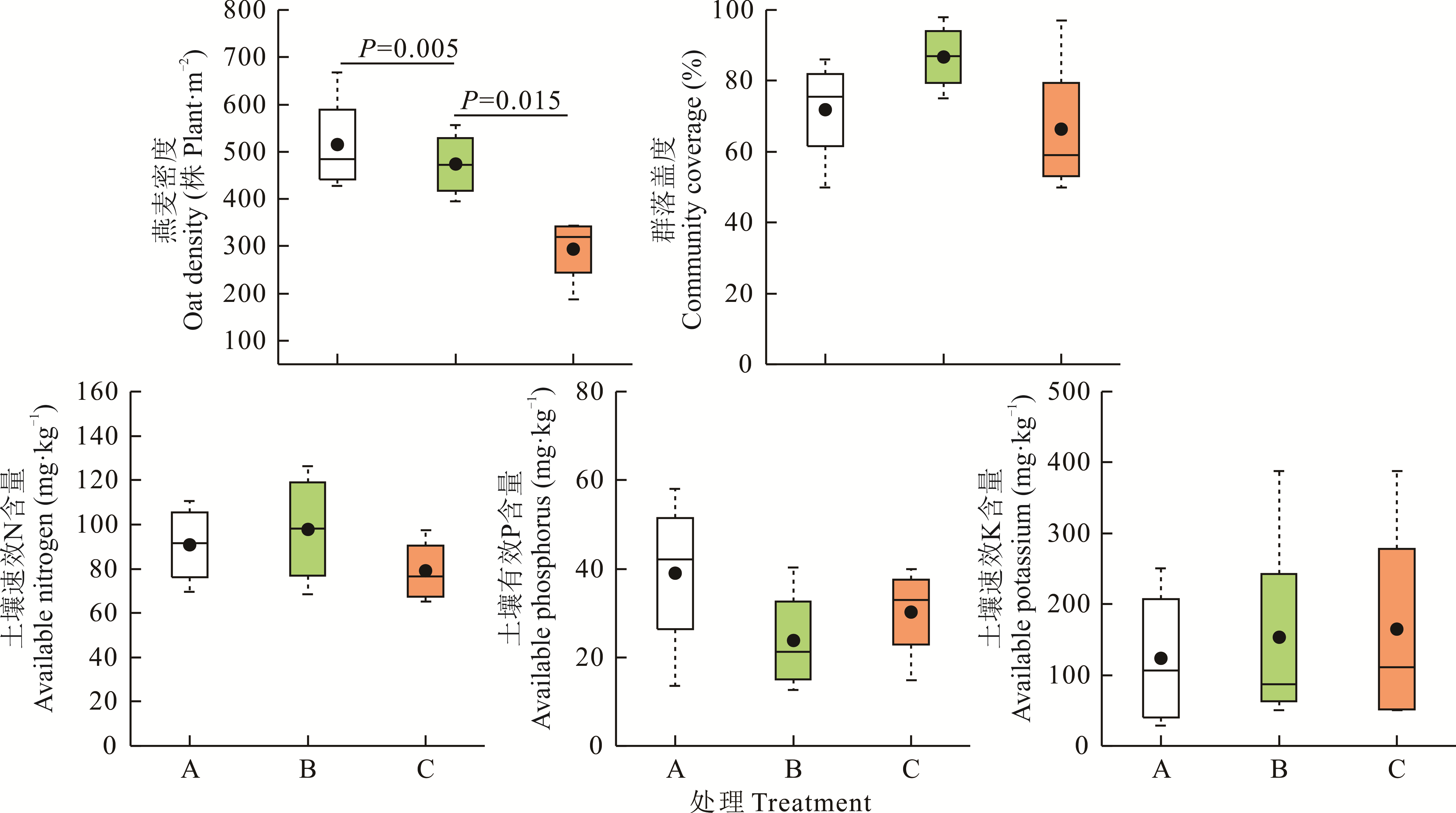

ISSN 1004-5759 CN 62-1105/S


草业学报 ›› 2021, Vol. 30 ›› Issue (6): 82-93.DOI: 10.11686/cyxb2020534
高鹏1( ), 魏江铭1, 李瑶1, 张丽红1, 赵祥1, 杜利霞1, 韩伟2
), 魏江铭1, 李瑶1, 张丽红1, 赵祥1, 杜利霞1, 韩伟2
收稿日期:2020-12-01
修回日期:2021-01-07
出版日期:2021-05-21
发布日期:2021-05-21
通讯作者:
高鹏
作者简介:Corresponding author. E-mail: zyjt_721@163.com基金资助:
Peng GAO1( ), Jiang-ming WEI1, Yao LI1, Li-hong ZHANG1, Xiang ZHAO1, Li-xia DU1, Wei HAN2
), Jiang-ming WEI1, Yao LI1, Li-hong ZHANG1, Xiang ZHAO1, Li-xia DU1, Wei HAN2
Received:2020-12-01
Revised:2021-01-07
Online:2021-05-21
Published:2021-05-21
Contact:
Peng GAO
摘要:
山西省大同市是我国饲用燕麦的主产区之一,叶部真菌病害已成为限制其生产的主要因素,但目前尚不清楚病害种类及病原。此外,早播燕麦罹患病害产生的侵染源可能增加复种植物病害流行风险,阻碍燕麦可持续生产,迫切需要明确影响早播燕麦病害发生程度的主要因素,有针对性地制定防治措施。鉴于此,利用形态学特征和致病性测定对大同市天镇县的早播饲用燕麦种植田发现的叶部真菌病害进行鉴定,并且分析了收获期病情指数和病害影响因素之间的关系。结果表明:早播饲用燕麦共发现3种由真菌引致的叶部病害,分别为禾谷炭疽菌(Colletotrichum cereale)引致的叶枯病,燕麦内脐孺孢(Drechslera avenacea)引致的条斑病和禾柄锈菌燕麦转化型(Puccinia graminis f. sp. avenae)引致的秆锈病。不同种植和管理方式下,饲用燕麦叶枯病、条斑病和秆锈病均有不同程度发生,病情指数均值分别在1.9~5.6,1.0~6.2和0~0.9。相关性分析表明:喷灌是导致条斑病发病严重的主要因素,豆禾混播能降低饲用燕麦叶枯病的发生程度。此外,土壤速效N和速效K含量也能影响叶枯病和秆锈病的发生。建议牧草种植者在生产饲用燕麦时,采用合理的灌溉和施肥模式,推广牧草混播等种植技术,使用低毒高效杀菌剂对早播饲用燕麦进行病害防治,保证饲用燕麦产业的可持续发展。
高鹏, 魏江铭, 李瑶, 张丽红, 赵祥, 杜利霞, 韩伟. 山西省大同市早播饲用燕麦叶部真菌病害病原鉴定及影响因素分析[J]. 草业学报, 2021, 30(6): 82-93.
Peng GAO, Jiang-ming WEI, Yao LI, Li-hong ZHANG, Xiang ZHAO, Li-xia DU, Wei HAN. Identification of fungal diseases and factors influencing disease index in oat (Avena sativa) crops in the Datong region of Shanxi Province, China[J]. Acta Prataculturae Sinica, 2021, 30(6): 82-93.

图1 山西省大同市不同种植和管理方式的早播饲用燕麦种植田a: 单播漫灌饲用燕麦田; b: 单播喷灌饲用燕麦田; c: 混播漫灌饲用燕麦田。a, b and c show oat planting and management pattern of monoculture and flooding irrigation, monoculture and sprinkling irrigation, mixture and flooding irrigation, respectively.
Fig. 1 Field of early sowing oats under different planting and management patterns from Datong in Shanxi

图5 饲用燕麦叶枯病(a)、条斑病(b)和秆锈病(c)病原离体接种及对照(d)叶片症状
Fig. 5 Symptoms of oat leaf spot (a), leaf streak (b), stem rust (c) and control (d) by inoculating isolate on detached oat leaves

图6 饲用燕麦叶枯病(a)、条斑病(b)和秆锈病(c)病原活体植株接种症状及对照(d)
Fig. 6 Symptoms of oat leaf spot (a), leaf streak (b), stem rust (c) and control (d) by inoculating isolate on living plants

图7 山西省大同市单播漫灌(A)、单播喷灌(B)和混播漫灌(C)下早播饲用燕麦收获期叶枯病、条斑病和秆锈病的病情指数上、下边缘分别表示最大值和最小值,箱体中的黑点和横线分别代表均值和中位数,P表示显著性水平,下同。Top and bottom of box show maximum value and minimum value, respectively; black dot and transverse line show mean value and median; P is the degree of significance, the same below.
Fig. 7 Disease index of leaf spot, leaf streak and stem rust under monoculture and flooding irrigation (A), monoculture and sprinkling irrigation (B), mixture and flooding irrigation (C), respectively, from Datong in Shanxi

图8 山西省大同市单播漫灌(A)、单播喷灌(B)和混播漫灌(C)的早播饲用燕麦种植田燕麦密度、群落盖度和土壤养分特征
Fig. 8 Density of oat, community coverage and soil nutrient of monoculture and flooding irrigation (A), monoculture and sprinkling irrigation (B), mixture and flooding irrigation (C), respectively, from Datong in Shanxi
项目 Item | 条斑病病情指数Streak disease index | 秆锈病病情指数Stem rust index | 喷灌 Sprinkling irrigation | 燕麦密度 Oat density | 群落盖度Community coverage | 速效氮 Available nitrogen | 有效磷 Available phosphorus | 速效钾Available potassium |
|---|---|---|---|---|---|---|---|---|
| 叶枯病病情指数Leaf spot disease index | 0.1608 | 0.0870 | 0.2048 | 0.9231* | 0.4974 | 0.6294* | 0.0350 | -0.5594* |
| 条斑病病情指数Leaf streak disease index | 0.1110 | 0.8194* | 0.2797 | 0.3713 | 0.2168 | 0.0490 | 0.1958 | |
| 秆锈病病情指数Stem rust index | 0.8547* | 0.2482 | 0.4444 | 0.7024* | 0.0521 | 0.2417 | ||
| 喷灌Sprinkling irrigation | 0.3073 | 0.5130 | 0.3073 | -0.3073 | 0.0512 | |||
| 燕麦密度Oat density | 0.5604* | 0.4965 | 0.0280 | -0.5385 | ||||
| 群落盖度Community coverage | 0.4694 | -0.3398 | -0.6725 | |||||
| 速效氮Available nitrogen | 0.1539 | -0.4126 | ||||||
| 有效磷Available phosphorus | 0.1329 |
表1 山西省大同市早播饲用燕麦叶枯病、条斑病和秆锈病病情指数与燕麦密度、群落盖度和土壤养分含量之间的相关矩阵
Table 1 Spearman’s rank correlation matrix between the disease index and oat density, community coverage and soil nutrient from Datong in Shanxi
项目 Item | 条斑病病情指数Streak disease index | 秆锈病病情指数Stem rust index | 喷灌 Sprinkling irrigation | 燕麦密度 Oat density | 群落盖度Community coverage | 速效氮 Available nitrogen | 有效磷 Available phosphorus | 速效钾Available potassium |
|---|---|---|---|---|---|---|---|---|
| 叶枯病病情指数Leaf spot disease index | 0.1608 | 0.0870 | 0.2048 | 0.9231* | 0.4974 | 0.6294* | 0.0350 | -0.5594* |
| 条斑病病情指数Leaf streak disease index | 0.1110 | 0.8194* | 0.2797 | 0.3713 | 0.2168 | 0.0490 | 0.1958 | |
| 秆锈病病情指数Stem rust index | 0.8547* | 0.2482 | 0.4444 | 0.7024* | 0.0521 | 0.2417 | ||
| 喷灌Sprinkling irrigation | 0.3073 | 0.5130 | 0.3073 | -0.3073 | 0.0512 | |||
| 燕麦密度Oat density | 0.5604* | 0.4965 | 0.0280 | -0.5385 | ||||
| 群落盖度Community coverage | 0.4694 | -0.3398 | -0.6725 | |||||
| 速效氮Available nitrogen | 0.1539 | -0.4126 | ||||||
| 有效磷Available phosphorus | 0.1329 |
| 1 | Gorash A, Armonienė R, Fetch J M, et al. Aspects in oat breeding: Nutrition quality, nakedness and disease resistance, challenges and perspectives. Annals of Applied Biology, 2017, 171(3): 281-302. |
| 2 | Sun J P, Dong K H, Kuai X Y, et al. Comparison of productivity and feeding value of introduced oat varieties in the heagro-pasture ecotone of Northern Shanxi. Acta Prataculturae Sinica, 2017, 26(11): 222-230. |
| 孙建平, 董宽虎, 蒯晓妍, 等. 晋北农牧交错区引进燕麦品种生产性能及饲用价值比较. 草业学报, 2017, 26(11): 222-230. | |
| 3 | Li C J, Chen T X, Zhao G Q, et al. Progress in research on diseases of Avena sativa. Acta Prataculturae Sinica, 2017, 26(12): 203-222. |
| 李春杰, 陈泰祥, 赵桂琴, 等. 燕麦病害研究进展. 草业学报, 2017, 26(12): 203-222. | |
| 4 | Yuan J H, Cao L X, Zhao S F, et al. Investigation on main oat diseases and pests in Northwest area of Hebei Province. Journal of Hebei North University (Natural Science Edition), 2015, 31(1): 35-39. |
| 袁军海, 曹丽霞, 赵世锋, 等. 冀西北地区燕麦主要病虫害调查. 河北北方学院学报(自然科学版), 2015, 31(1): 35-39. | |
| 5 | Nie X M, Zhao G Q, Sun H Y, et al. Incidence of oat leaf spot and pathogen identification in the main oat production areas of Gansu Province. Acta Prataculturae Sinica, 2020, 29(4): 157-167. |
| 聂秀美, 赵桂琴, 孙浩洋, 等. 甘肃省燕麦主产区叶斑病调查及病原鉴定. 草业学报, 2020, 29(4): 157-167. | |
| 6 | Weir B S, Johnston P R, Damm U. The Colletotrichum gloeosporioides species complex. Studies in Mycology, 2012, 73: 115-180. |
| 7 | Gao P, Nan Z B, Wu Y N, et al. Indentification of the pathogen causing rust disease of traditional Chinese herb Apocynum venetum. Journal of Plant Protection, 2017, 44(1): 129-136. |
| 高鹏, 南志标, 吴永娜, 等. 罗布麻锈病病原菌鉴定. 植物保护学报, 2017, 44(1): 129-136. | |
| 8 | Zhang W, Damm U, Crous P W, et al. Anthracnose disease of carpetgrass (Axonopus compressus) caused by Colletotrichum hainanense sp. nov. Plant Disease, 2020, 104: 1744-1750. |
| 9 | Hyde K D, Chomnunti P, Crous P W, et al. A case for re-inventory of Australia’s plant pathogens. Persoonia, 2010, 25: 50-60. |
| 10 | Nilsson R H, Ryberg M, Kristiansson E, et al. Taxonomic reliability of DNA sequences in public sequence databases: A fungal perspective. PLoS One, 2006, 1(1): e59. |
| 11 | Motovilin A N. Responsiveness of oats varieties on fungicides application against red-brown spot. Protection and Quarantine of Plants, 2000(10): 30. |
| 12 | Gao P, Nan Z B, Christensen M J, et al. Factors influencing the epidemiology of rust disease (Melampsora apocyni) on wild and cultivated Apocynum venetum. Phytopathology, 2019, 109(4): 593-606. |
| 13 | Bao S D. Soil agrochemical analysis. Beijing: China Agriculture Press, 2000. |
| 鲍士旦. 土壤农化分析. 北京: 中国农业出版社, 2000. | |
| 14 | Nan Z B, Li C J. Fungal diseases of pasture plants recorded in China-a check list. Pratacultural Science, 1994, 11(Supple 1): 3-30. |
| 南志标, 李春杰. 中国牧草真菌病害名录. 草业科学, 1994, 11(增刊): 3-30. | |
| 15 | He S Q, Jing Z Q, Zhao G Q, et al. Identification of the pathogen of oat anthracnose in Wulanchabu city of Inner Mongolia Autonomous region. Plant Protection, 2015, 41(3): 68-72. |
| 何苏琴, 荆卓琼, 赵桂琴, 等. 内蒙古自治区乌兰察布市燕麦炭疽病病原鉴定. 植物保护, 2015, 41(3): 68-72. | |
| 16 | Jiang G Z. Graminicolous species of Helminthosporium from China. Acta Phytopathologica Sinica, 1959, 5(1): 21-37. |
| 姜广正. 中国禾本科植物上的蠕形菌(Helminthosporium). 植物病理学报, 1959, 5(1): 21-37. | |
| 17 | Zhang X Y, Sun X M, Zhou H Y, et al. Identification and biological characteristics of leaf spot pathogen Drechslera avenacea in oat. Journal of Plant Protection, 2017, 44(3): 473-480. |
| 张笑宇, 孙雪梅, 周洪友, 等. 燕麦叶斑病病原菌鉴定及其生物学特性. 植物保护学报, 2017, 44(3): 473-480. | |
| 18 | Selby A D, Manns T F. Studies in diseases of cereals and grasses. Ohio of Agricultural Experiment Station, 1909, 203: 195-203. |
| 19 | Saccardo P A. Sylloge fung XXII: Deuteromyceta, Melnnconlaces, Melanconlum. Pavia, 1913: 1208. |
| 20 | Fragoso R G. Botanical series (NO.7)-New contribution to mycological flora Guadarrama: Teleomycetes and Deuteromscetes. Madrid: Classic Spanish Printing, 1914: 54-55. |
| 21 | Hyde K D, Cai L, Cannon P F, et al. Colletotrichum-names in current use. Fungal Diversity, 2009, 39: 147-182. |
| 22 | Sutton B C. The Coelomycetes: Fungi imperfecti with pycnidia, acervuli and stromata. Wallingford: CABI (Centre Agriculture Bioscience International), 1980. |
| 23 | Crouch J A, Clarke B B, White Jr J F, et al. Systematic analysis of the falcate-spored graminicolous Colletotrichum and a description of six new species from warm-season grasses. Mycologia, 2009, 101(5): 717-732. |
| 24 | Jayawardena R S, Hyde K D, Damm U, et al. Notes on currently accepted species of Colletotrichum. Mycosphere, 2016, 7(8): 1192-1260. |
| 25 | Cannon P F, Damm U, Johnston P R, et al. Colletotrichum-current status and future directions. Studies in Mycology, 2012, 73: 181-213. |
| 26 | Ito S. On some new ascigerous stages of the species of Helminthosporium parasitic on cereals. Proceedings of the Imperial Academy, 1930, 6(8): 352-355. |
| 27 | Roemer J D. New magazine for botany in its entirety, Volume 1. Zurich: Bey Ziegler and Sons Press, 1794: 119. |
| 28 | Erikss J, Henning E. The main results of a new study on grain rusts. Journal of Plant Diseases, 1894, 4(2): 71. |
| 29 | Leonard K J, Szabo L J. Stem rust of small grains and grasses caused by Puccinia graminis. Molecular Plant Pathology, 2005, 6(2): 99-111. |
| 30 | Motovilin A N, Strigekozin J A. Estimation of oats basic disease harmfulness. Protection and Quarantine of Plants, 2000, 7: 28. |
| 31 | de Paiva Custódio A A, Ampélio Pozza E, de Paiva Custódio A A, et al. Effect of center-pivot irrigation in the rust and brown eye spot of coffee. Plant Disease, 2014, 98: 943-947. |
| 32 | Garrett K A, Mundt C C. Effects of planting density and the composition of wheat cultivar mixtures on stripe rust: An analysis taking into account limits to the replication of controls. Phytopathlogy, 2000, 90: 1313-1321. |
| 33 | Clark R V. Comparison of spot blotch severity in barley grown in pure stands and in mixtures with oats. Canadian Journal of Plant Pathology, 1980, 2: 37-38. |
| 34 | Dietz J I, Schierenbeck M, Simón M R. Impact of foliar diseases and its interaction with nitrogen fertilization and fungicides mixtures on green leaf area dynamics and yield in oat genotypes with different resistance. Crop Protection, 2019, 121: 80-88. |
| 35 | Amtmann A, Troufflard S, Armengaud P. The effect of potassium nutrition on pest and disease resistance in plants. Physiologia Plantarum, 2008, 133: 682-691. |
| [1] | 王辛有, 曹文侠, 王小军, 刘玉祯, 高瑞, 王世林, 安海涛, 邓秀霞, 王文虎. 河西地区豆禾混播草地生产性能对刈割高度与施肥的响应[J]. 草业学报, 2021, 30(4): 99-110. |
| [2] | 吴晓娟, 杨梅, 芦奕晓, 杨惠敏. 混播比例和施氮肥对箭筈豌豆/燕麦草地根系特性的影响[J]. 草业学报, 2020, 29(9): 106-116. |
| [3] | 谢开云, 曹凯, 万江春, 王玉祥, 赵云, 朱进忠. 新疆半干旱区不同豆科/禾本科牧草混播草地生产力的变化研究[J]. 草业学报, 2020, 29(4): 29-40. |
| [4] | 谢开云, 王玉祥, 万江春, 张树振, 隋晓青, 赵云, 张博. 混播草地中豆科/禾本科牧草氮转移机理及其影响因素[J]. 草业学报, 2020, 29(3): 157-170. |
| [5] | 张永亮, 于铁峰, 郝凤, 高凯. 施肥与混播比例对豆禾混播牧草产量及氮磷钾利用效率的影响[J]. 草业学报, 2020, 29(11): 91-101. |
| [6] | 朱亚琼, 于辉, 郑伟, 黎松松, 娜尔克孜, 刘岳含, 郝帅, 艾丽菲热. 燕麦+箭筈豌豆混播草地混播优势的测度与影响因素分析[J]. 草业学报, 2020, 29(1): 74-85. |
| [7] | 王富强, 向洁, 郭宝光, 余成群, 沈振西, 邵小明. 拉萨河谷区箭筈豌豆和黑麦混、间播建植方式研究[J]. 草业学报, 2018, 27(8): 39-49. |
| [8] | 李蕾蕾, 花登峰, 郑兴卫, 李聪. 含水量和混播比例对青南牧区燕麦-箭筈豌豆/毛苕子混播青贮品质的影响[J]. 草业学报, 2018, 27(7): 166-174. |
| [9] | 李晶,李娜,丁品,杨海兴,刘锦霞,武建荣,杜文静,张建军. 黄帚橐吾提取物对保护地辣椒4种病原真菌的抑制活性及其病害防效[J]. 草业学报, 2018, 27(4): 56-68. |
| [10] | 邝肖,季婧,梁文学,崔国文,冀国旭,崔新,刘建,胡国富. 北方寒区紫花苜蓿/无芒雀麦混播比例和刈割时期对青贮品质的影响[J]. 草业学报, 2018, 27(12): 187-198. |
| [11] | 朱亚琼, 关正翾, 郑伟, 王祥. 混播种类和群体结构对豆禾牧草混播系统氮素利用效率的影响[J]. 草业学报, 2018, 27(10): 1-14. |
| [12] | 朱亚琼, 郑伟, 王祥, 关正翾. 混播方式对豆禾混播草地植物根系构型特征的影响[J]. 草业学报, 2018, 27(1): 73-85. |
| [13] | 罗永清, 赵学勇, 王涛, 李玉强, 左小安, 丁杰萍. 植物根系分解及其对生物和非生物因素的响应机理研究进展[J]. 草业学报, 2017, 26(2): 197-207. |
| [14] | 刘文辉, 张英俊, 师尚礼, 贺永娟, 孙建, 魏小星. 高寒区施肥和豆科混播水平对燕麦人工草地土壤酶活性的影响[J]. 草业学报, 2017, 26(1): 23-33. |
| [15] | 徐杉, 李彦忠. 箭筈豌豆真菌病害研究进[J]. 草业学报, 2016, 25(7): 203-214. |
| 阅读次数 | ||||||
|
全文 |
|
|||||
|
摘要 |
|
|||||